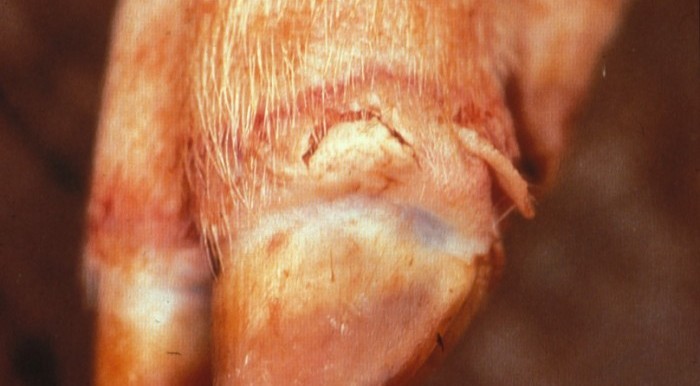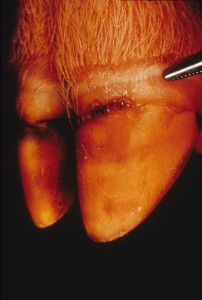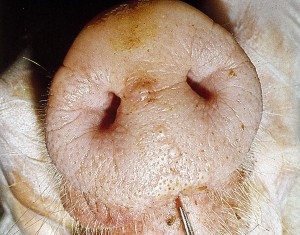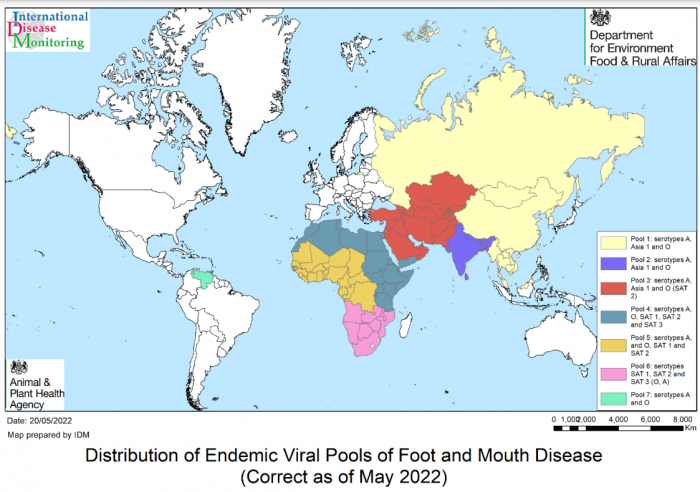The NPA’s Rebecca Veale outlines the latest information on vesicular diseases like foot-and-mouth, which remains endemic in some parts of the world.
The most well-known vesicular disease is foot-and-mouth disease (FMD), although there are others including swine vesicular disease, vesicular stomatitis and Seneca valley virus, the first two of which are also notifiable.
What do they look like?
Signs of foot-and-mouth disease in pigs include:
- sudden lameness, which may spread quickly among the herd
- loudly squealing from pain
- tendency to lie down and unwillingness to move
- reluctance to feed.
Pigs can also develop blisters (lesions), on the upper edge of the hoof where the skin and horn meet and on the snout – although more obvious on the foot. These blisters can rupture and heal rapidly, often crusting over so that they no longer look like blisters.
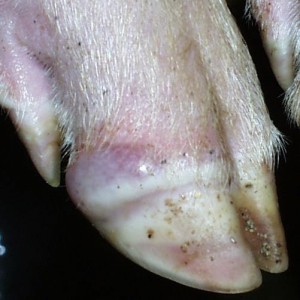
Pictures – Pig Veterinary Society
Other vesicular diseases have identical clinical signs so any suspected vesicular disease must legally be reported to APHA, this can be done directly or via the private vet.
If you suspect notifiable disease contact APHA as follows:
England: call Defra Rural Services Helpline 03000 200 301
Wales: call 0300 303 8268
Scotland: contact the local Field Services Office.
The global picture
FMD is endemic in some parts of the world, including Africa, India, Russia, Venezuela, China and other parts of Asia. The World Organisation of Animal Health (WOAH) monitors the serotypes to map them and better understand any movements or jumps in disease.
FMD serotype O has been detected in Indonesia this year, an area previously FMD-free (without vaccination). Failure to detect and control the initial clinical cases has led to the rapid spread of the disease across five main islands, including Bali. The emergence of FMD there coincided with annual large movements of people and animals in Indonesia during the Lebaran holiday period; this is a stark reminder of how quickly and easily disease can move.
Risk to the UK
The risk to the UK livestock remains low, as it is illegal for travellers from Asia and other third country areas to bring meat or dairy products into the UK. Australia and other countries in the region will be concerned about the developments in Indonesia, with the large numbers of tourists who travel from the affected region to Australia.
Advice from the Pig Veterinary Society
Producers and vets are reminded to be extra vigilant and investigate any increase in lameness, including in sows, thoroughly.
Pig keepers should inspect their pigs at least once a day and be vigilant for lameness and blisters or crusting on the foot or snout/mouth. Pigs should be observed moving to be able to detect lameness as they may appear otherwise healthy.
Inspection of lame pigs may require the feet to be washed to inspect the feet properly especially in wet conditions or where wallows are present. Snout lesions are more transient and may be harder to notice in an outdoor setting.
More generally, a strict approach to biosecurity helps prevent pathogens from entering a unit. AHDB has produced useful biosecurity information and posters https://ahdb.org.uk/knowledge-library/biosecurity-on-pig-farms
APHA recommends that contact with other pigs should be avoided for 72 hours after people’s last contact with pigs on premises affected with, or suspected to be affected with, vesicular disease.




